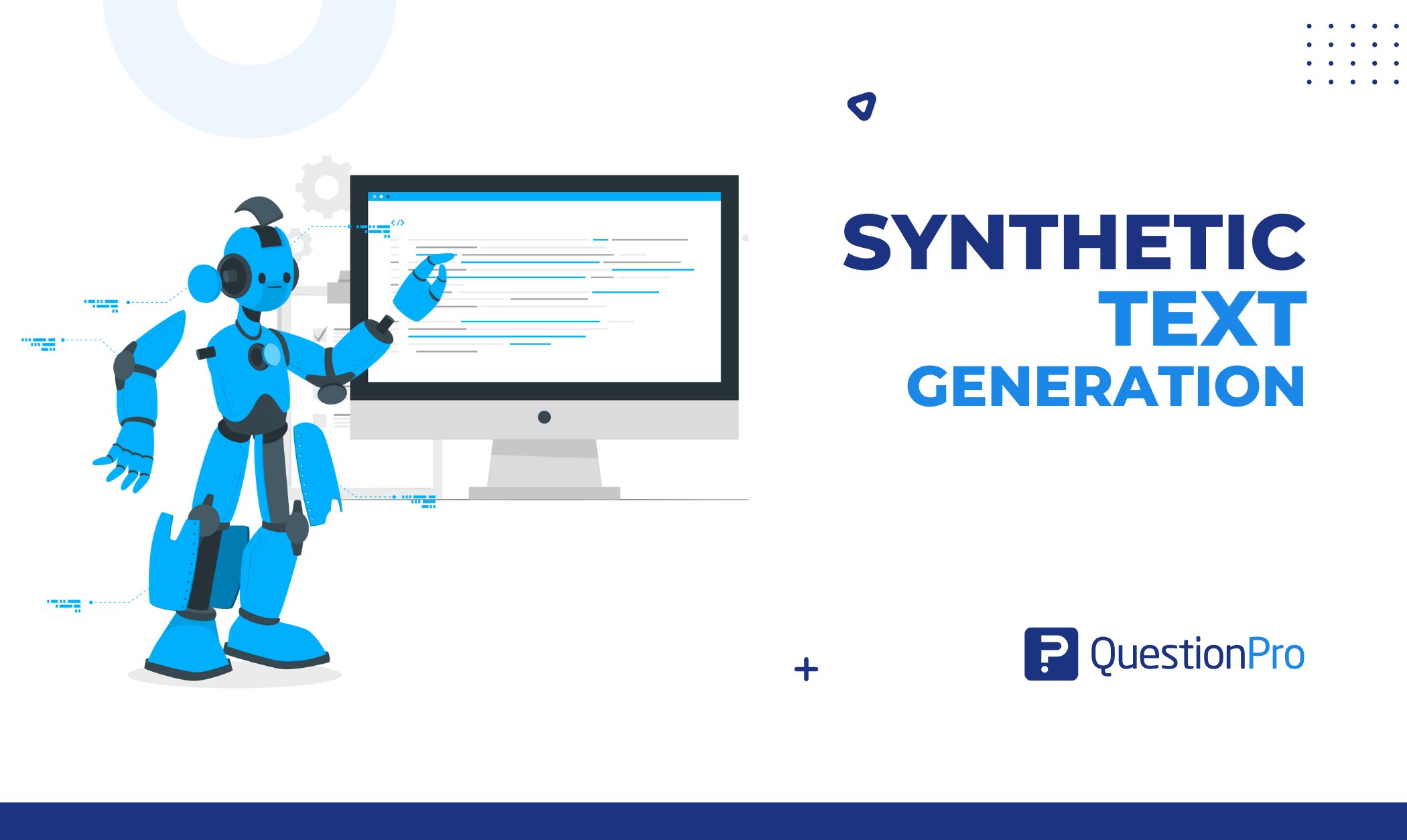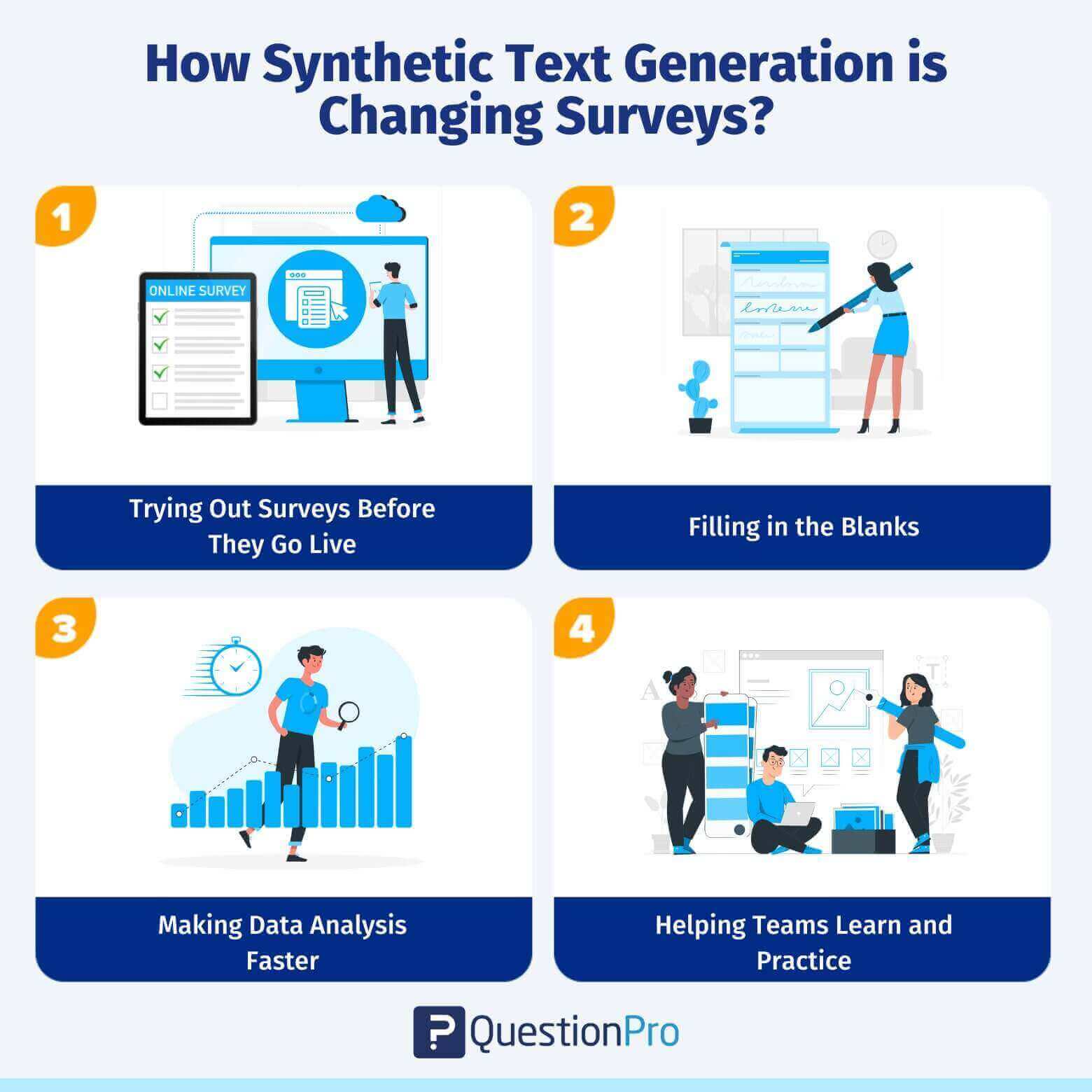
What if you could create sample survey responses, analyze feedback, or test your questions — all without waiting for real participants? That’s exactly what synthetic text generation allows you to do.
It’s now possible for computers to generate realistic survey answers in seconds with the help of artificial intelligence. These AI tools can create responses that sound natural, follow a certain tone, and even reflect different viewpoints, just like a real respondent would.
In this blog, we’ll explore what synthetic text generation means for survey research and how it is changing surveys. If you’re looking for smarter ways to improve your survey process, keep reading!
What is Synthetic Text Generation?
Synthetic text generation is a way to create fake but realistic written answers using computer programs. In surveys, it means using smart technology to automatically generate text responses that sound like real people wrote them.
Sometimes, when you run a survey, you might not get enough answers, or you want to test how your questions work before sharing them with real people. Synthetic text generation helps by making sample responses that look and feel like actual answers.
These generated responses can help researchers check their survey design, train tools to understand text answers better, and protect real people’s privacy by using artificial data instead of actual responses.
Synthetic text generation helps improve surveys by giving you more realistic data to work with, even if it’s not from real respondents.
Also Check: What is Synthetic Data? Types, Examples & Use Cases
How Synthetic Text Generation is Changing Surveys?
Surveys have always been a trusted way to hear directly from people, whether it’s a business asking customers for feedback or a government gathering public opinions. They help decision-makers understand what really matters to people.
But now, something new is shaking things up: synthetic text generation. This smart technology is quietly changing how surveys are created, tested, and analyzed, making the whole process smoother and smarter. Here’s how:

1. Trying Out Surveys Before They Go Live
Ever wondered if your survey questions make sense to everyone? With synthetic text generation, researchers can now “test drive” their surveys. AI can create realistic sample responses, helping teams spot confusing questions, unclear wording, or missing topics, all before sending them to real people.
2. Filling in the Blanks
We’ve all seen those super short answers like “I don’t know” or skipped questions. They don’t tell you much. Synthetic text can help by generating fuller, realistic responses based on patterns from similar answers. This gives researchers better context and richer data to work with.
3. Making Data Analysis Faster
Reading through tons of survey responses takes a lot of time. When people give open-ended answers, it can feel like you’re digging for insights in a huge pile of text.
Synthetic text generation helps speed things up. Along with AI tools, it can sort through responses, pick out common ideas, and even give quick summaries of what people are really saying.
This means researchers spend less time reading every single answer and more time focusing on the big picture. It makes finding useful insights faster and a whole lot easier.
4. Helping Teams Learn and Practice
Sometimes, teams need a bit of practice before they work with real survey responses — whether it’s learning how to analyze answers, trying out a new tool, or just getting comfortable with the process.
But waiting for real data isn’t always an option. That’s where synthetic text generation helps. It can quickly create realistic sample answers that feel like real responses.
- New team members can practice sorting and analyzing feedback.
- Teams can check if their tools or systems are working correctly.
- It’s a simple, safe way to practice before the real data comes in.
This way, everyone gets the chance to learn, make mistakes, and feel ready when it really counts.
Recommended Read: Synthetic Data Generation: Techniques and Considerations
How QuestionPro is Innovating with AI & Synthetic Data?
QuestionPro is making survey research smarter and simpler with the help of AI and synthetic data. Its AI tools are designed to save time, make data analysis easier, and help researchers get better results without extra effort.
Here’s how QuestionPro is making a difference:
Faster and Smarter Data Analysis
Analyzing survey responses can often feel overwhelming, especially when dealing with thousands of open-ended answers. Manually sorting through all that text takes time and can delay important decisions. QuestionPro’s AI can make data analysis faster, easier, and more insightful.
Here’s how QuestionPro AI helps:
- Quickly scans large volumes of text to find common themes and patterns.
- Group similar responses together to give a clear overview of feedback.
- Detects sentiment so you know if respondents feel positive, negative, or neutral.
- Generates easy-to-understand summaries that highlight key insights.
- Learns and adapts over time to improve accuracy and relevance.
With these smart features, QuestionPro AI turns complex data into clear, actionable insights in a fraction of the time it would take manually. This means you can focus on making decisions and improving your products, services, or processes without getting bogged down in data analysis.
Testing Surveys with Synthetic Responses
Before you send a survey out to real people, it’s a good idea to test it first. QuestionPro’s AI makes this easy by creating synthetic (fake but realistic) responses that help you see how your survey works in action.
With synthetic responses, you can:
- Check the question flow and logic
- See if your questions are clear and easy to understand.
- Review how different types of answers look — open-ended, multiple choice, ratings, etc.
- Spot and fix mistakes or confusing parts before your survey goes live.
By testing with synthetic responses, you get a chance to fine-tune your survey and make sure it works smoothly. It helps you collect better data and gives your real respondents a better experience.
Keeping Respondent Information Safe
Protecting the privacy of survey participants is one of the most important responsibilities in research. With QuestionPro’s AI and synthetic data features, it becomes easier to handle this responsibly.
Instead of using real answers that may contain personal or sensitive details, researchers can generate synthetic responses that look real but don’t reveal any actual information. This means you can analyze data, share reports, or run tests without risking anyone’s privacy.
It also helps meet privacy rules and regulations, giving both researchers and respondents peace of mind. With synthetic data, QuestionPro helps you collect insights while keeping personal information safe and secure.
Helping Teams Train and Experiment
Whether you’re teaching a new team member or trying out new features, QuestionPro’s AI-generated data gives you a safe, realistic way to practice and experiment, with no need to wait for real survey responses.
Learn More: Synthetic Data Generation Tools & Platforms
Conclusion
Synthetic text generation is changing the way surveys are designed, tested, and analyzed. From creating realistic sample responses to speeding up data analysis and protecting respondent privacy, it’s clear this AI-powered technology is reshaping the survey research process.
With tools like QuestionPro AI, researchers can now test surveys before launch, analyze open-ended responses faster, and even train teams more effectively, all without relying solely on real participant data. It saves time, reduces risks, and helps you make smarter decisions backed by better insights.
As survey research continues to evolve, synthetic data generation stands out as a practical, reliable, and innovative solution for modern researchers. Whether you’re aiming for better data quality, faster results, or stronger privacy protection, synthetic text powered by AI is a tool worth embracing.
Frequently Asked Questions (FAQs)
Answer: Synthetic text generation allows researchers to test the flow, clarity, and logic of surveys by generating sample responses. This helps identify confusing questions or gaps before the survey reaches real respondents.
Answer: Yes, synthetic text generation, combined with AI analysis tools, can speed up the process of reviewing open-ended survey responses. It helps sort data, detect common themes, and even summarize feedback for easier analysis.
Answer: Absolutely. Synthetic text generation creates artificial responses that mimic real data but do not contain any personal or sensitive information. This ensures privacy while still allowing meaningful insights and analysis.
Answer: No, synthetic text generation is mainly used for testing, training, and analysis support. It complements real data by helping prepare surveys, fine-tune analysis tools, and protect privacy, but real responses are still needed for actual research insights.
Answer: QuestionPro integrates synthetic text generation through its AI tools to help researchers test surveys, analyze responses faster, protect participant data, and offer realistic training datasets, making the survey process smarter and more efficient.







